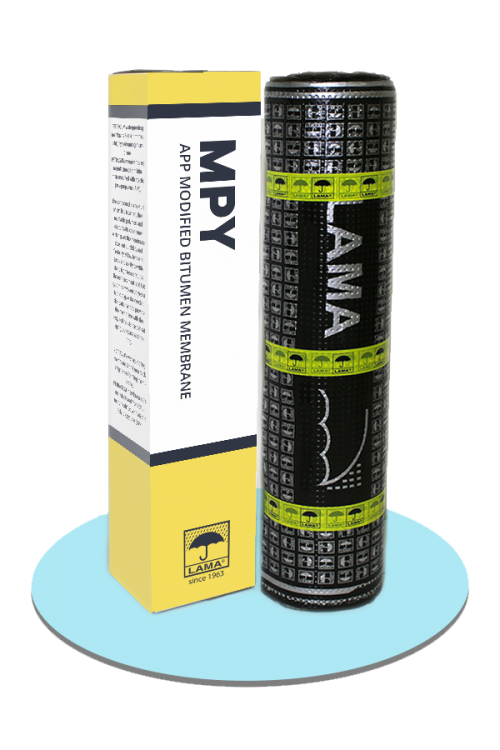MPY
MPY is a highly performing membrane. Its compound with -15°C cold flexibility along with the 200 g/m² non-woven spun-bonded polyester reinforcement grant a safe and long-lasting application in any weather condition and in any civil or industrial work. The membrane is available with protective and decorative finishes for exposed applications.
MPY membranes 4 or 5 mm thick, are manufactured from bitumen modified with atactic polypropylene (APP). The compound is a mixture of distilled bitumen, thermoplastic polymers (TP) and elastoplastic copolymer (EPC) which gives the membrane excellent durability and flexibility at very low temperatures and the ability to withstand high temperatures.
The reinforcement is 200 g/m² nonwoven fabric spun-bonded polyester to give the best elongation results and to provide the membrane with the required resistance to heat aging and puncture, and rotproofing characteristics. The lower film, while the upper surface is covered with fine sand, granule or colored slates when the membrane is used as the exposed top layer.

Key Features.
- Excellent weathering and aging resistance.
- High flexibility at low temperatures.
- Hydrostatic pressure resistance.
Packaging Information.
- Dimension: 1×10 m/roll
- Thickness: 4 or 5 mm
- Weight per roll: 50 or 62 Kg
- Reinforcement: Nonwoven Polyester 200 g/m²
Application Field.
Due to its extraordinary heat resistance, low-temperature flexibility and good work ability, MPY is used in a wide range of demanding waterproofing such as:
- Roofs (reinforced concrete, prefabricated concrete, metal and timber deck).
- Multi-story car parks.
- Underground foundations, basements, and retaining walls.
- Reservoirs, basins and canals.
- Swimming pools.
Application Method.
- Lay down the rolls so that the lower face with polyethylene film is bonded to the substrate.
- To fix the sheet to the substrate, melt off the polyethylene film and a thin layer of bitumen while unrolling and laying the membrane. Side laps 100 mm and end laps 150 mm to be reheated and smoothed on with a hot round-tipped trowel.
- The membrane may be loosely laid, partially or fully bonded, depending on the structure and the specifications.
